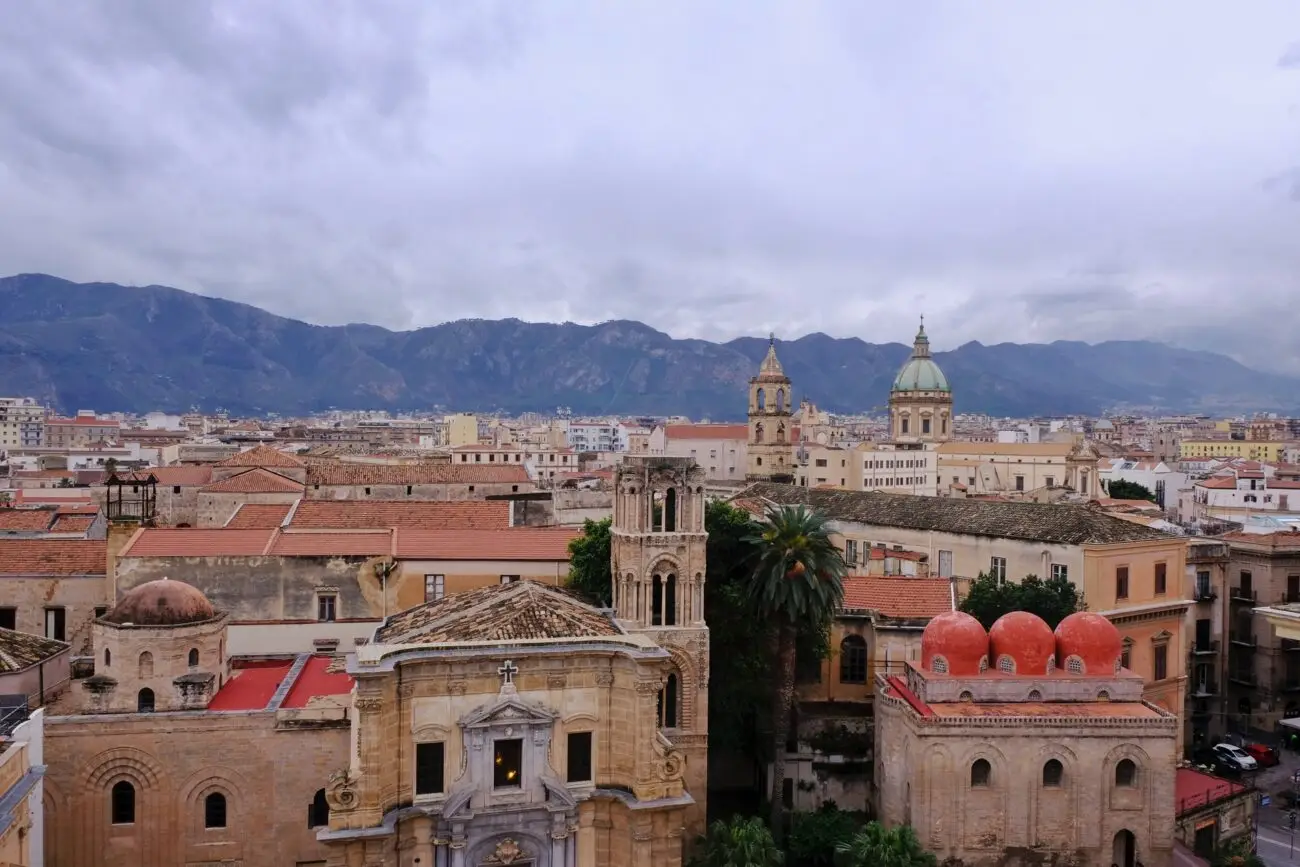I didn’t expect much from winter in Palermo. It was the final stop of my Sicily adventure, and by then I thought I’d seen it all. But even beneath grey skies and rain-soaked streets, the city pulsed with life, layered history, and unexpected moments of quiet awe. Over four days, I wandered through ancient churches, chaotic markets, and sleepy seaside towns, discovering the contradictions and charm that define Palermo. It’s gritty, it’s golden, and it’s not trying to impress you—yet somehow, it does.
If you’re visiting Palermo in the off-season, this guide—woven with personal stories, sensory snapshots, and real travel tips—is for you.
Day 1: Arrival in Palermo – Rain, Stairs, and Familiar Smells
I boarded the bus to Palermo with a little bit of dread. Not because I expected the worst—far from it—but because this marked the last leg of my Sicily trip. And as much as I’d been on the move, part of me wasn’t ready for it to end.
The ride from Ortigia was beautiful, even in that dreary winter rain that drapes everything in a sleepy blue. I watched the landscape shift past my window, already missing the slow charm of the seaside island I had just left. (You can read about my time in Ortigia here).

We arrived at Palermo Centrale just as the sun gave up trying to break through the clouds. The walk to my Airbnb was about ten minutes straight down Via Roma—an easy route made less easy by what awaited me at the end: another round of Sicilian stairs. But this one took the cake. Narrow, steep, and with the final flight missing a handrail entirely. An upper-body workout disguised as a welcome.
This time, I wasn’t staying in an entire flat—I’d booked a room in someone’s home. A home that included an eager dog, who greeted me like an old friend. No better welcome committee.
I didn’t do much that first evening. My body was done in by those stairs, and the rain hadn’t let up. But I did step out for a little wander, just to get my bearings. The streets were slick and quiet, but every now and then, a string of twinkly lights appeared overhead—like a gentle reminder that Christmas had only just passed. The air smelled unmistakably of coriander and cumin. There were grocers, Indian restaurants, and souvenir shops run by Bangladeshis lining the damp streets. It reminded me so much of Little India in Singapore that I stopped mid-step, caught in a strange blend of homesickness and curiosity.
I’d read that La Kalsa had a reputation—“gritty,” “rough around the edges,” “a little sketchy.” But it didn’t feel threatening. Not that night. Not in the rain. Maybe because it was still early. Maybe because I walked with purpose (thank you, Google Maps). Or maybe because something about the place felt familiar in a way I hadn’t expected.
Eventually, I followed the flow of foot traffic and landed in front of Teatro Massimo—Italy’s largest opera house, and for fans of The Godfather, the iconic location where Mary Corleone is tragically shot on the steps. Cue dramatic slo-mo drop to her knees, eyes wide, looking at her father, and then the gut-wrenching scream that echoes through the square. What I found was a bit different: twinkly lights wrapped around the columns, a Christmas tree perched at the top of the staircase, and poinsettias cascading down the middle like a red velvet river. The drama was still there, just… softer. More festive. Less mafia, more mistletoe.
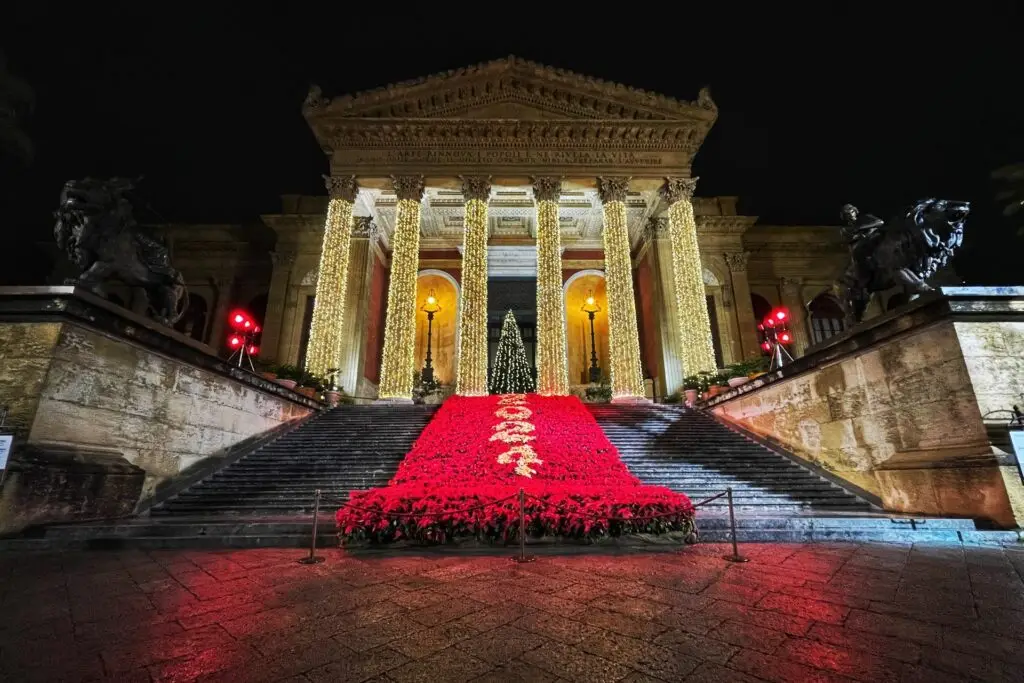
I stood there for a while, rain speckling my glasses, wondering what the next few days would reveal. Palermo had already shown me a side I hadn’t expected. And I’d only just arrived.
Day 2: Markets, Churches, and My Architecture Fangirl Moment
The rain hadn’t let up, but I’d made peace with it by now. Besides, I was centrally located and determined not to let the weather dictate the day. With an umbrella in one hand and soggy optimism in the other, I headed to Ballarò Market.
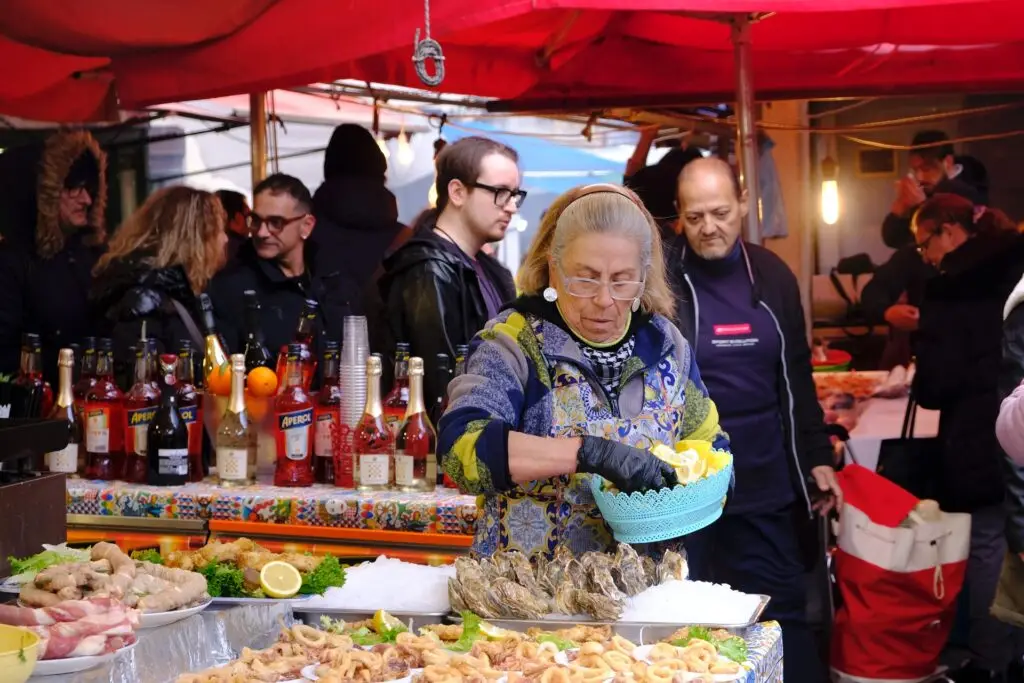
If Ortigia was all clean lines and honeyed calm, Ballarò was its chaotic, smoke-scented cousin. You enter through what feels like an alleyway, and suddenly it opens up—loud, wet, and alive. Tarps flap overhead, vendors shout in Sicilian, and steam curls from sizzling food carts. The cobblestones were slick, and the air was thick with citrus, frying oil, and charcoal smoke. I passed stalls heaving with fresh produce, wheels of cheese, and trays of golden arancine—some round, some conical, all glistening with promise.
It’s not curated. It’s not sanitized. It’s Palermo raw and unfiltered—and I loved it.
I tore myself away from the food long enough to start my unofficial church-hopping circuit, beginning with Chiesa del Gesù (Casa Professa). This was Baroque at full volume. I used to dismiss Baroque in art school—too much ornament, not enough soul. But walking into this 16th-century church felt like entering a jewel box crafted by someone with a flair for the dramatic and no concept of restraint. Swirling marble, golden flourishes, cherubs climbing toward domes—it was all there, and somehow it worked.
A few streets away, I wandered into Church of the Most Holy Savior (Chiesa del Santissimo Salvatore). Originally built in the 11th century and later transformed into a Baroque beauty, it’s known for its central dome and elegant curves. The dome was closed to visitors that day (thanks, rain), but I didn’t mind. I had the entire space to myself, save for a janitor quietly sweeping in the corner like a background character in a very ornate dream. What many people don’t realize is that the church used to be even larger—part of it was destroyed by bombing during World War II, and that portion has since been converted into an auditorium. Standing there, soaking in the mood and acoustics, I couldn’t help but imagine a younger version of me—mic in hand, heart pounding—getting ready to play a show in a space like this. The silence made everything feel surreal. Moody light filtered in through the arches, casting soft shadows on black-and-gold detailing. Like Casa Professa, it was dripping in Baroque drama—less ornate, maybe, but no less captivating.
The rain let up a little as I made my way to Palermo Cathedral (Cattedrale di Palermo). If you’ve ever Googled Palermo, this is probably the image that pops up first—honey-coloured stone, palm trees, and a mash-up of styles that somehow don’t clash. Arab, Norman, Gothic, Baroque—it’s like five architects tried to outdo one another and accidentally built something iconic.
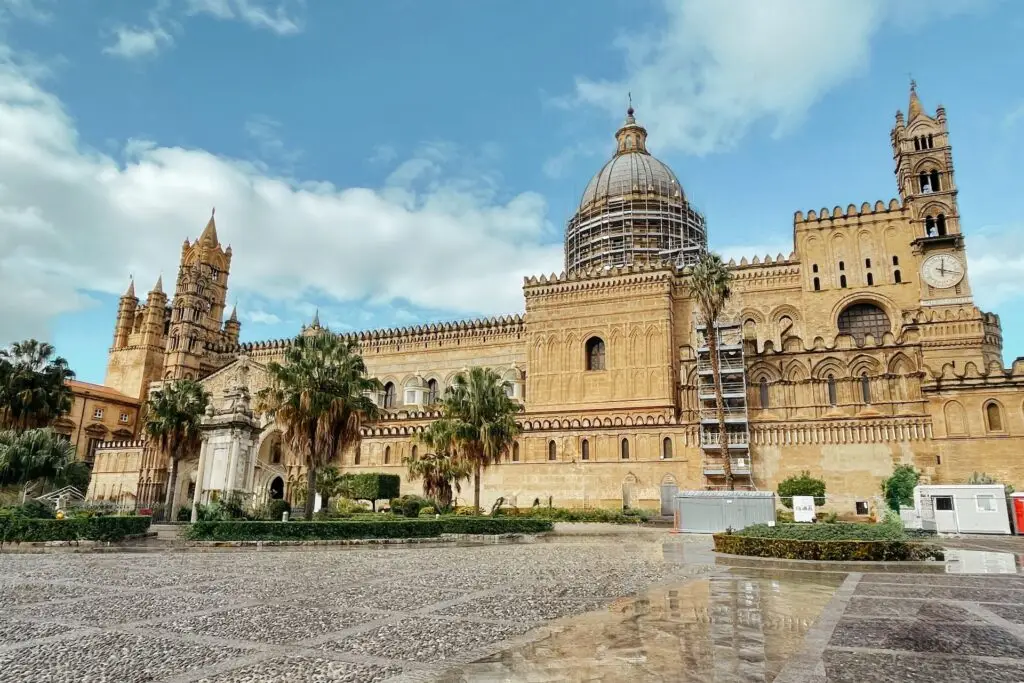
It was beautiful, yes, but packed. Tour groups swarmed the exterior, selfie sticks in hand, and the buzz kind of took the magic out of it. I gave the royal tombs a miss and opted for a walk through the main hall, which felt cavernous but less emotive than the smaller churches I’d just left. I lingered outside longer than I did inside, admiring the oddball mix of domes and arches and letting the crowd move around me.
Up next was the Norman Palace (Palazzo dei Normanni). I walked in not expecting much—and was instantly smitten. I wandered through a temporary exhibit I barely glanced at (sorry, curator), but the building itself stopped me in my tracks. The arches! Vaulted, layered, geometric—my inner architecture geek was fully activated. Total fawning moment. Sometimes it’s not about what’s displayed inside the space—it’s the space itself that steals the show.
And then came the Palatine Chapel (Cappella Palatina)—small, yes, but absolutely breathtaking. You enter, and suddenly it’s gold, gold, gold. Every surface shimmers with Byzantine mosaics that seem to flicker with life as the light hits them. It took eight years to complete, and it’s said that millions of mosaic tiles were used—each one painstakingly placed by hand. The ceiling—an elaborately carved muqarnas-style woodwork—was unlike anything I’d ever seen. I didn’t speak. I didn’t want to. I just stood there, eyes wide, quietly overwhelmed. I had to wipe my glasses, only to realize it wasn’t just rain—my eyes had welled up. I was so moved by the beauty of the space I actually teared up. I must’ve spent close to an hour inside, photographing every corner, completely lost in the glow of it all. And when I finally emerged, I bought a souvenir gold coin from the vending machine outside. A little cheesy, but I needed to take something of that moment with me. A talisman of awe.
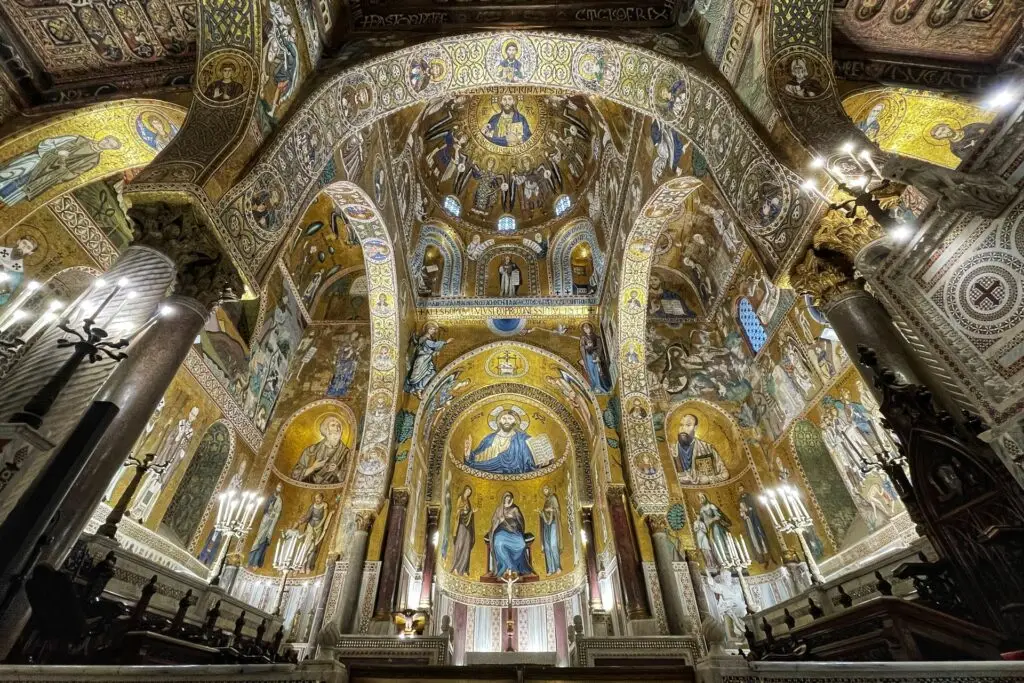
To wind things down, I visited Chiesa di San Giovanni degli Eremiti (Church of St. John of the Hermits)—more famous for its architecture than its atmosphere. The three red domes were striking, and the inner courtyard, scattered with orange trees, was peaceful. Aside from that, there wasn’t much else to linger over. But it did have that photogenic quality—one of those places perfect for a flying dress photoshoot. You know the type.
From there, I set out with the intention of finding a gift for my dad—but got entirely sidetracked by a shop selling hand-painted tiles. It was cramped and overflowing, and I carefully picked out a few small, colorful pieces I could somehow wedge into my already overweight suitcase. The shopkeeper told me they weren’t Sicilian, but Tunisian. Fair enough. Still got them.
Eventually, I found my way to Mascari Francesco, a family-run shop known for its traditional Sicilian coppola hats. The owner showed me a full spread—every fabric, every color. I chose a light blue checkered linen one for my dad, imagining him in it instantly. Before leaving, I asked if I could take a photo of the owner at his work table, and he kindly obliged.

That’s when I realized—I’d completely forgotten to visit the Museum of Majolica Tiles (Museo delle Maioliche – Stanze al Genio). A whole museum dedicated to tiles, bookmarked since the start… and I missed it. The irony was not lost on me.
I ended the day with a late lunch. A warm, simple meal to close out a full day of wandering, worship, and just the right amount of wonder.
Day 3: Cefalù and the Calm I Didn’t Know I Needed
Day 3 brought something I hadn’t seen in a while—sunlight. Not a dramatic burst, but the kind that creeps in soft and golden, like it’s asking permission to stay. I took it as a sign. I grabbed my things and hopped on a morning train to Cefalù, a seaside town on Sicily’s northern coast, just about an hour from Palermo.
Though it’s often labelled a beach destination, what I found felt more like a village still in hibernation. Quiet streets. A slower rhythm. No sunburnt tourists with selfie sticks. Just women out marketing for the day, elderly men in groups of three or four chatting on benches, and locals going about their routines as if the Tyrrhenian Sea wasn’t a few steps away.
I made my way to the historical centre, with the Cefalù Cathedral (Duomo di Cefalù) as my starting point. But it was partly boarded up for what looked like never-ending “renovations.” I lingered briefly before moving on, letting the town lead the way.
The cobbled streets guided me toward Porta Marina, a small stone archway that opens up to a view of the sea so perfectly framed, it could pass for a Renaissance painting. Just through that arch, the water shimmered in winter tones—slate-blue and pale silver—and the shoreline lay quiet. I later found out this spot made a brief appearance in Indiana Jones and the Dial of Destiny, during a chase scene where young Teddy Kumar gets kidnapped. The irony wasn’t lost on me—this place felt like the last place you’d expect an action sequence.
I wandered down to the wharf where a few locals were scattered along the edge, some sitting in silence, others casting fishing lines lazily into the water. The waves rolled in and out with a steady rhythm, and for a moment, I just… stood still. Across the water, I turned back and looked at the town from a distance—the stacked terracotta rooftops, the cathedral towers, and La Rocca, the great rock rising behind it all like a protective sentinel.
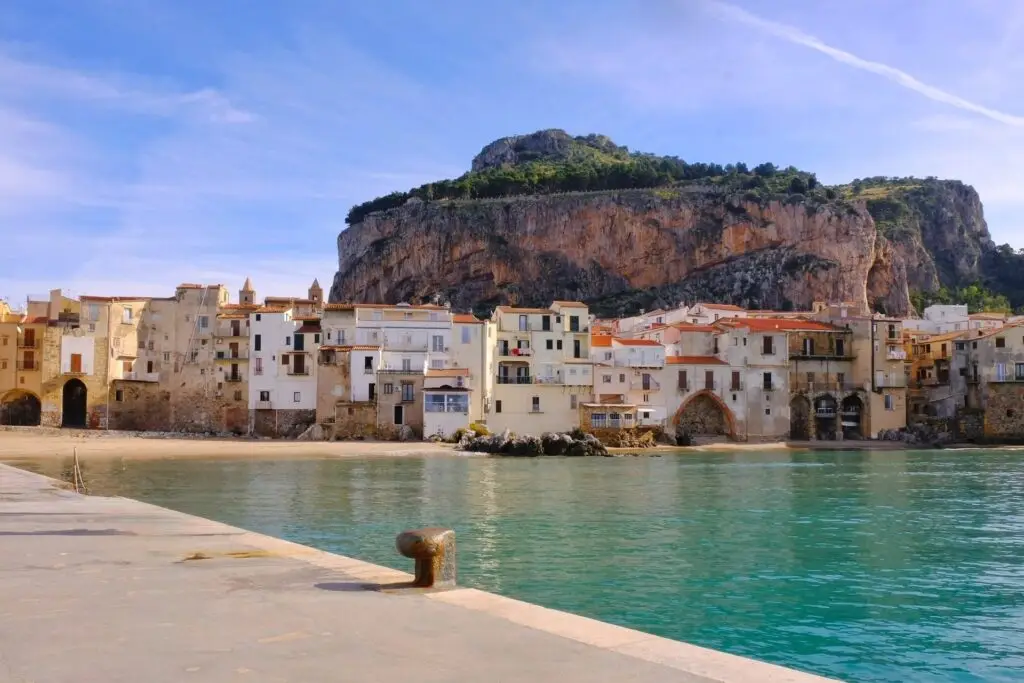
That exact view had once been the screensaver on my phone—a makeshift vision board of sorts, a dream I’d quietly set for myself. And here I was, no longer staring at it through a screen, but standing right in front of it. The full-circle feeling was gentle but undeniable—like I’d stepped into a version of the future I’d once only hoped for.
A scene from Cinema Paradiso drifted into my head—where the townspeople watch Ulysses outdoors until a storm breaks the spell. That was filmed here too. But today, there was no storm. Just sea breeze, soft chatter, and the occasional sound of shutters creaking open.
At the far end of the wharf, I noticed a metal railing with clusters of rusty love locks. Names and initials barely legible now, weathered by salt air and time. Fleeting promises, maybe. But still holding on.
Of course, my moment of introspection couldn’t last forever—my camera, ever the drama queen, decided to act up. The battery wouldn’t charge properly, no matter how many times I willed it to. So, I surrendered to my phone camera. Not ideal, but it was what it was. I wasn’t about to let a dying battery ruin a perfectly good afternoon.
I wandered back through town, past shuttered shops and souvenir stands half-heartedly open. I stopped by Sfrigola Cefalù for a hot, crispy arancino—non-traditional, maybe, but still a warm comfort in hand. Not far from there, tucked just off the street, I came across the Medieval Washhouse (Lavatoio Medievale Fiume Cefalino). A small stone staircase leads down to the old basins where generations of women once washed their laundry in icy stream water. The space is small, almost hidden, but preserved beautifully. I lingered for a bit, imagining the noise and laughter that might’ve once echoed there.
As the sun dipped lower, the streets grew even quieter. I passed a shop where an elderly man sat weaving fishing nets by hand, his movements slow and precise. A few steps away, I spotted a small art studio—Art Studio – SiciliaDipinta—just one room, filled with original watercolour paintings of Cefalù landscapes and street scenes, all in varying sizes, from wall-ready pieces to tiny ones you could tuck in your palm. Naturally, I didn’t walk away empty-handed. I’ve somehow developed a habit of collecting art from the places I visit. Nothing expensive, just little windows into where I’ve been. One day, I’ll frame them all.
By early afternoon, I’d checked off everything on my (very short) list. Most shops had closed for the day—it was, after all, winter… and siesta hour. I slowly made my way back to the train station just as school let out, swept along by a wave of backpacks and chatter.
Back in Palermo, the pace felt quicker again. It was still early afternoon, and the city had that post-lunch hum—the kind where people spill back into the streets, shops reopen, and everything starts moving again. The skies were still clear. After a full morning of calm in Cefalù, I wasn’t ready to stop.
I headed straight from the train station to the Church of Saint Mary of the Admiral (Chiesa di Santa Maria dell’Ammiraglio). Unfortunately, it was closed when I arrived. Right beside it, however, was the Church of Saint Catald (Chiesa di San Cataldo)—a smaller, more austere space with clean lines and its iconic three red domes. The interior felt more Arabic-Norman than Catholic, with geometric mosaic floors and a quiet, restrained presence. It was beautiful in its simplicity, but I still craved something more layered—something to end the day with feeling.
Luckily, just around the corner was the Church and Monastery of Saint Catherine of Alexandria (Chiesa e Monastero di Santa Caterina d’Alessandria). I hadn’t known exactly what to expect—but it ended up being one of the most extraordinary places of the trip.
You enter the church first—and it is Baroque of all Baroques. From the outside, you’d never guess what’s waiting inside. The moment I stepped through the doors, I froze. The sheer scale, the drama, the detail—every inch was doing the most. A single soaring nave wrapped in layers of marble and gold, with columns and cornices and flourishes that curled, climbed, and glittered in the light. Statues lined the walls like they were mid-monologue. Light streamed through high windows and landed on surfaces so ornately layered, I wasn’t sure where to look first. It didn’t whisper devotion—it announced it.

It felt like stepping into a stage set designed by someone who had been handed unlimited marble, mood lighting, and divine permission to be extra.
After the theatrical overload of the church, I followed the signs that led me out to the cloistered courtyard and into the former monastery. The contrast was immediate—suddenly, I was walking through hushed hallways and the nuns’ sleeping quarters, each room barely larger than a closet. A bed. A cross. A shelf. A tiny window looking out onto stone and sky. It was the kind of silence that makes you reflexively soften your steps.
Then I climbed the winding staircase to the rooftop.
And suddenly—Palermo. In every direction. Warm rooftops, sunlit domes, and just below, the sculpted drama of the Fontana Pretoria—nude marble figures frozen mid-pose around a grand circular basin, gleaming white against the stone piazza. From above, it looked like the set of an opera paused at intermission. The city stretched out beyond it: terracotta, limestone, and a soft, overcast sky.
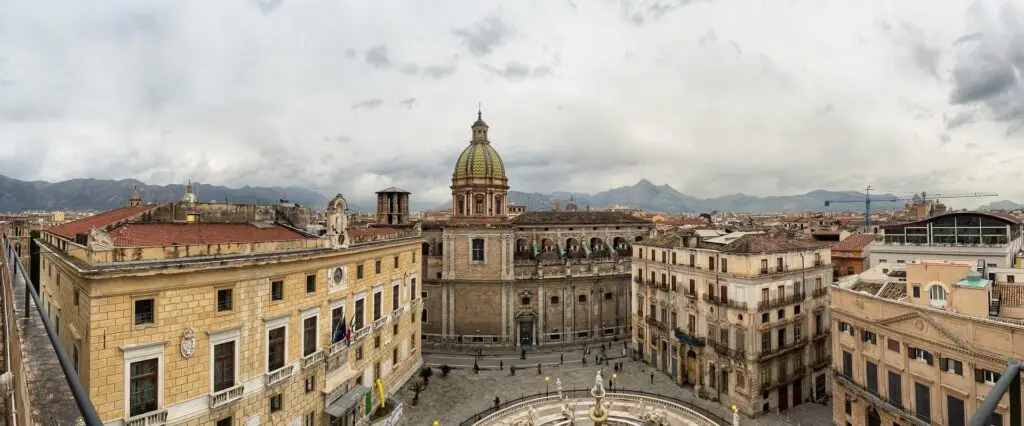
And the best part? I had the roof to myself. Just me, the view, and whatever the sky had planned.
I reached for my camera—more out of habit than hope—and to my surprise, it powered on. After refusing to work all day in Cefalù, it blinked back to life like nothing had happened. I toggled carefully between it and my phone, wary not to jinx the moment. Everything felt still. Focused. Like the city was holding its breath.
And then it happened.
A murmuration of starlings appeared—closer and more breathtaking than the one I’d seen the week before in Rome. I stood still as they spiraled and danced across the sky, a living wave of instinct and motion. It looked like calligraphy written in air.
I filmed it with my phone, heart somewhere near my throat. The whoosh of wings, the shapes shifting and collapsing and rebuilding mid-air—it wasn’t just beautiful, it was consuming. It felt like something ancient and precise and unrepeatable was happening above me, just for a moment. A show written for no one, but somehow performed just for me.
It didn’t just pass overhead—I felt the soft rush of air move right through me.
Eventually, the birds dissolved into the horizon, and the stillness returned. A few minutes later, two other visitors stepped onto the terrace. The spell softened, respectfully released.
Eventually, the birds disappeared into the horizon, and the stillness settled in. Then, right on cue, the rain began to fall again—soft and steady—as two other visitors stepped onto the rooftop. The spell lifted, gently and without fuss.
I walked back down with a full heart, quietly counting my blessings. It had all been magic.
Day 4: Rain, Paper Finds, and a Quiet Goodbye
My last day in Palermo began the way it ended: in the rain. A steady, moody drizzle that felt less like an inconvenience and more like a gentle send-off. I didn’t rush. There was nowhere left I urgently needed to be, nothing big left to tick off—just a few quiet errands and whatever the day decided to hand me.
Before heading out, I asked my Airbnb host about a lovely piece of art she had framed on the wall. She told me it came from a little shop just a few streets behind us, so off I went, umbrella in hand.
The place was called ideestortepaper—a small bookshop and creative studio tucked into a side street. The owner explained that each whimsical illustration had originally been created for the children’s books they publish. Some had been turned into postcards, prints, or zines. There were stacks of paper things, artful and thoughtful and strange in the best way. Naturally, I left with a small stash of souvenirs I had no space for but couldn’t leave behind.
From there, I made my way to Capo Market, trying to dodge puddles and scooter splashes as I went. Compared to Ballarò, it was more compact and slightly more polished, but still full of life. I picked up some pasta spices to bring home—an edible reminder of the flavours I didn’t want to forget. By this point, my coat was damp again, and I was undeniably, thoroughly churched out.
Still, I ducked inside one last one—Church of the Immaculate Conception (Chiesa dell’Immacolata Concezione)—tucked right inside the market itself. It was more elaborate than expected, with richly decorated chapels and gilded flourishes. I stayed just long enough to admire it, then slipped back out into the rain.
As I walked back toward Teatro Massimo, I realised I was on the edge of being fungry. I’d bookmarked Basile Focacceria del Massimo, said to be popular with locals, and it delivered. A handwritten menu on the wall, order first, then bring the receipt to the counter. A hot plate of pasta and a can of Coke cost me just €5.50. It was exactly what I needed.
Recharged, I joined the guided tour of Teatro Massimo. The space was grand in every sense—red velvet seats, golden balconies, and soaring ceilings designed for drama. Every detail whispered opulence, without feeling untouchable. As we walked through one of the side corridors, I heard voices—soft, layered, echoing. A choir, rehearsing somewhere in the building. It felt like a secret soundtrack added just for us. I lingered at the edge of the stage, imagining the curtain lifting.
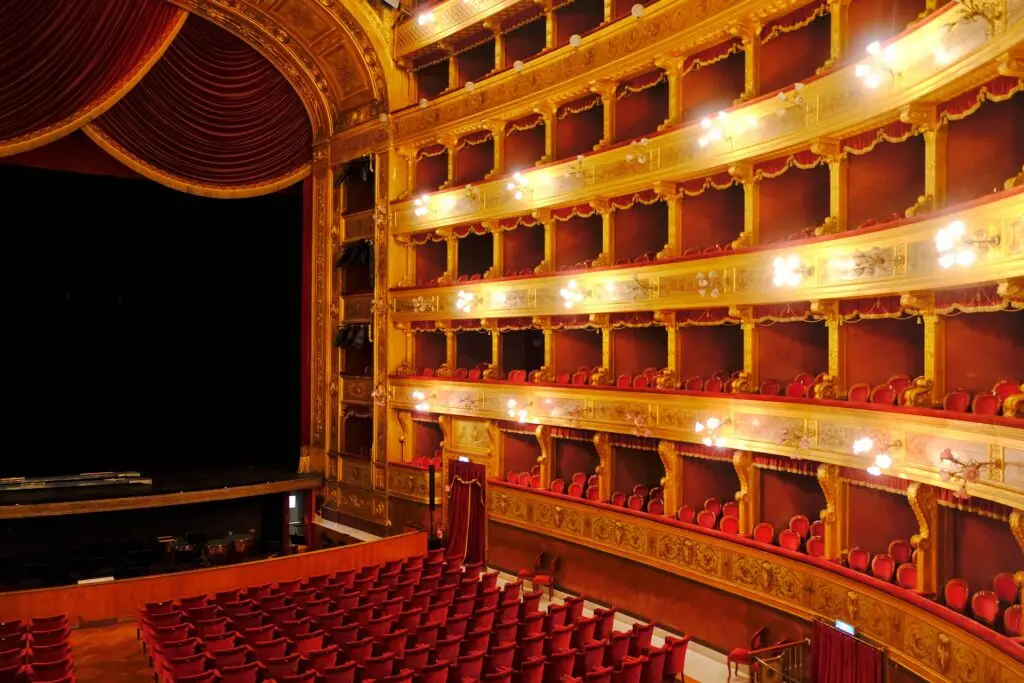
My final cultural stop was the No Mafia Memorial (No Mafia Memoriale). A sobering, powerful museum that tells the story of Sicily’s anti-Mafia movement. It doesn’t glorify—it humanises. Through documents, photos, and personal accounts, it honours the judges, journalists, activists, and everyday people who stood up and paid the price. I left quiet. Heavy, but grateful.
The rest of the afternoon blurred into last-minute souvenir hunting and regret—mostly for not packing lighter. I grabbed a pizza to go from Biga (because what’s one more carb at this point?) and returned to my apartment to face the inevitable: packing and mentally preparing for the next morning’s transit adventure.
I’d missed the deadline to book a group taxi from the train station (you need to do it at least 24 hours in advance), but thankfully, the alternative was simple. The next morning, I took the train to the airport—a direct ride that drops you off right underneath the terminal. Easy, efficient, and exactly what my travel-anxious brain needed.
Final Reflection: A Rainbow Farewell
I wrote this in my phone notes shortly after the plane took off from Palermo.
I sat there, phone to the window, filming one last glimpse of the city as the plane climbed. Low clouds hung over Mount Pellegrino, towering above the rooftops like a quiet guardian. I kept filming, even as the view began to blur—until something appeared through the mist.
A rainbow.
I hadn’t seen a rainbow in more than a year. And I often wondered why—why I wasn’t lucky, why those moments of quiet beauty seemed to escape me. In the past, whenever I did catch one, it brought a flicker of joy. A reminder that maybe I was okay. Maybe things were okay.
This trip, I saw five. Maybe more.
And that final faint arch of colors was the last, like bidding arrivederci, see you again. I guess when they say there’s a pot of gold at the end of the rainbow, for me that pot of gold was Sicily.
Written 12 Jan, on the flight.
Plan your own itinerary
Visit
- Teatro Massimo – Iconic opera house with red velvet seats, gilded balconies, and guided tours (you might even catch a choir rehearsal if you’re lucky).
- Ballarò Market – Raw, chaotic, alive. Think sizzling arancine, shouting vendors, flapping tarps, and the smell of frying oil.
- Capo Market – Slightly neater than Ballarò but still full of local colour. Tuck in behind the stalls to find unexpected gems like a Baroque church.
- Palermo Cathedral (Cattedrale di Palermo) – A mash-up of Arab, Norman, Gothic, and Baroque architecture. Be sure to visit the roof for panoramic views over the city.
- Church of the Immaculate Conception (Chiesa dell’Immacolata Concezione) – Gilded interiors tucked right inside Capo Market.
- Church and Monastery of Saint Catherine of Alexandria (Chiesa e Monastero di Santa Caterina d’Alessandria) – Over-the-top Baroque beauty, a cloistered monastery, and a rooftop view you won’t forget.
- Sanctuary of San Giuseppe dei Teatini (Chiesa di San Giuseppe dei Teatini) – I missed out on this grand Baroque church with a striking tiled dome near Quattro Canti.
- No Mafia Memorial (No Mafia Memoriale) – Sobering and powerful. A must for understanding the island’s modern history.
- Cefalù (day trip) – A sleepy seaside town just an hour away by train. Best for moody coastal walks, arched doorways, and that perfect painterly view of the town and La Rocca.
- Porta Marina – A romantic sea-facing archway in Cefalù (also seen in Indiana Jones).
- Monreale Cathedral (Cattedrale di Monreale) – Just half an hour from Palermo. I missed it this time, but it’s a must-see with dazzling mosaics and sweeping views—enough reason on its own to return to Palermo.
- Quattro Canti – An iconic Baroque square where four facades represent the four seasons, four Spanish kings, and four patron saints. I walked past it often, but under the cover of an umbrella, it was hard to fully take in its symmetry and grandeur.
- The Capuchin Catacombs – A haunting but fascinating site with preserved bodies and mummies of Palermo’s past—an eerie look at centuries of local funerary tradition.
- Orto Botanico (Botanical Garden) – One of Europe’s oldest botanical gardens, founded in the late 1700s. A living museum of plants from all over the world, with rare species and palm-lined paths perfect for a quiet wander.
Eat
- Basile Focacceria del Massimo – A no-fuss local spot just by the theatre. Handwritten menu, pay-first system, pasta for €5.50. Unpretentious and satisfying.
- Biga – My go-to. I didn’t do big meals in Palermo, but I always grabbed a slice or two from Biga—reliable, comforting, and always hit the spot.
- Assud a Santamarina Pizzeria Siciliana – Traditional Sicilian pizzeria serving wood-fired pizzas and regional specialties in a casual setting.
- Basile Focacceria del Massimo – A no-frills local eatery known for affordable pasta, focaccia, and quick Sicilian comfort food near Teatro Massimo.
- Sfrigola Cefalù – Grab a non-traditional arancino and wander with it. Comfort food in crispy form.
Shop
- Capo Market & Ballarò Market – Great for food souvenirs like dried pasta spices and herb blends.
- ideestortepaper – A tiny publishing house/bookshop filled with original art and printed ephemera. Perfect for paper lovers and quirky gift hunters.
- Art Studio – SiciliaDipinta (Cefalù) – Father-daughter watercolor works of local landscapes. Small pieces you can tuck in your palm or suitcase. Location map
- Mascari Francesco – Shop known for coppola hats. Fair prices. I got one for my dad here. Location map.
Stay
- Airbnb in La Kalsa – Top-floor room in a private apartment, great for solo travellers and close to all the main sights. Lovely terrace, friendly dog, and a heads-up: the final flight of stairs is very steep and has no handrail.
There will be a more suggestive list in my Palermo guide. – Coming soon!
Getting There / Getting Around
- Getting in by Plane – Palermo is served by Falcone Borsellino Airport (PMO), located about 35 km from the city. From the airport, you can take a direct train to Palermo Centrale—it runs frequently and takes about 1 hour. Train fare is approximately €6.80.
- Airport Transfer – Autoradio Taxi offers a shared taxi service between Palermo Centrale and the airport (and vice versa). Best to book at least 24 hours in advance. €10 per passenger (min 4 passengers). A private taxi costs around €50. To book, WhatsApp: +39 331 328 4403
- From Ortigia to Palermo – You can reach Palermo by bus or train. (Here’s my Ortigia post if you’re planning a combo trip.)
- From Catania to Palermo – Direct intercity buses and trains connect the two cities. The train ride takes around 3 hours, and the bus is slightly quicker. Buses are often the more comfortable option.
- Day Trip to Cefalù – Trains run regularly and take about 1 hour. Very doable in half a day.
- Public Transport – Walk when you can. Most attractions are central. Buses and regional trains are frequent but not always punctual.
- Train Tips – Use the Trenitalia app (or Trenit, which is also great for schedule comparisons) to book train tickets or check timings. If you’re taking a regional train, always validate your ticket before boarding using the small green machines at the station.
Keep Exploring Sicily
If you enjoyed this story, you might also like:
- Taormina in Winter: A Solo Traveler’s Peaceful Escape
- New Year in Catania – My Winter Trip to Sicily’s Black City
- Why I Fell in Love with Ortigia, Sicily – A Solo Travel Guide & Story
- Winter in Palermo – A Travel Story of Rain and Resilience
Along the way, I squeezed in unforgettable side trips to places like Savoca, Mount Etna, Cefalù, and the Valley of the Temples. Each one added a different color to the Sicilian palette.
